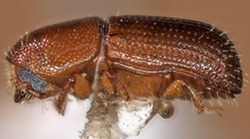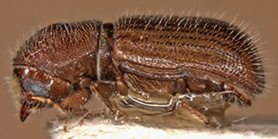Bark beetles are small (0.5 to 9.0 mm long), cylindrical, and usually range from light-brown to black in color. The taxonomic status of the group is not clearly defined. Some experts group them into a family of the Curculionoidea while others into a subfamily of the Curculionidae. In this tool, we follow J. F. Lawrence and A. F. Newton, Jr. (1995) and treat them as the subfamily Scolytinae (Curculionidae).
The world fauna of bark beetles consists of over 5,812 described species grouped in 225 genera (Wood and Bright 1992). In North America there are approximately 519 species of bark beetles.
Bark beetles are phytophagous and can cause extensive damage to their host, burrowing their way through the plant. Other types of beetles may use only specific structures of their host for their development without causing significant damage to it. Some bark beetles can also vector diseases which can cause additional damage or mortality to plants of ecological and economical importance.
Fifty-four of the species occurring in the U.S. are here as result of introductions. Exotic species typically enter through the nation’s ports of entry in plants and wood shipping palettes that come from around the world. APHIS created the ‘Port Information Network’ database of pests detected at the nation’s ports of entry. From 1985 to 2001, 34% of the 6,825 Scolytinae specimens detected were identified by this effort (Haack, 2001).
The following are some exotic species which have a high risk of introduction into the USA; it should be noted that all belong to native occurring genera. This tool will aid only in the identification of these species to the genus level.
Non-native specimens from the following genera were frequently collected at several ports of entry across the United States from 1985 to 2005: Carphoborus, Cryphalus, Crypturgus, Dryocoetes, Hylastes, Hypocryphalus, Hypothenemus, Phloeosinus, Pityophthorus, and Polygraphus. Native species from all these genera occur in the U.S. In addition, specimens from the exotic genera Taphrorychus and Cyrtogenius, which do not occur in the U.S., have also been frequently intercepted.

